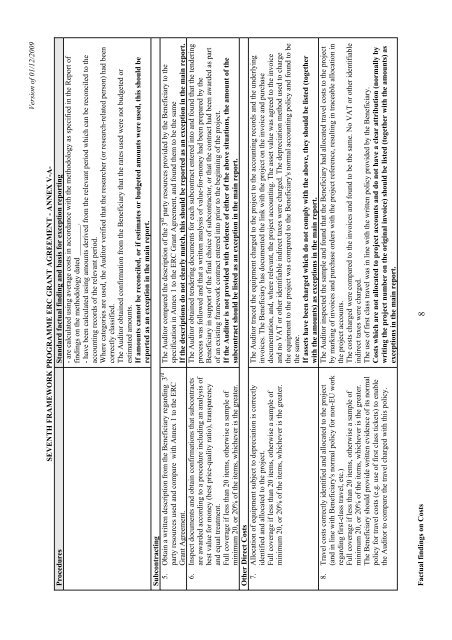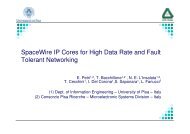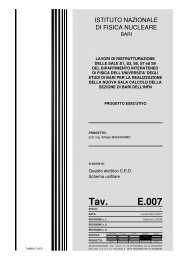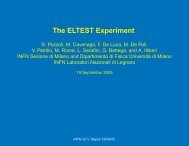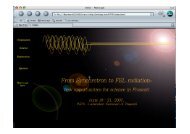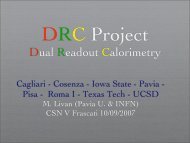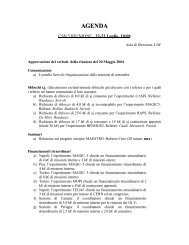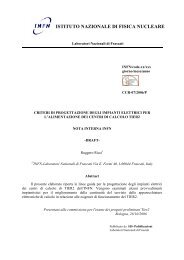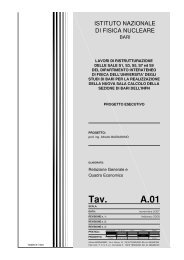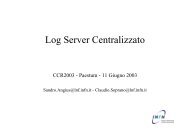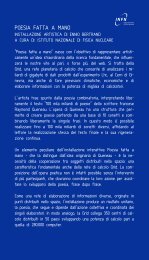5 1.9 Scope of Work â Compulsory Report Format and ... - Infn
5 1.9 Scope of Work â Compulsory Report Format and ... - Infn
5 1.9 Scope of Work â Compulsory Report Format and ... - Infn
Create successful ePaper yourself
Turn your PDF publications into a flip-book with our unique Google optimized e-Paper software.
Version <strong>of</strong> 01/12/2009<br />
SEVENTH FRAMEWORK PROGRAMME ERC GRANT AGREEMENT - ANNEX V-A-<br />
Procedures St<strong>and</strong>ard factual finding <strong>and</strong> basis for exception reporting<br />
- are calculated using average costs in accordance with the methodology as specified in the <strong>Report</strong> <strong>of</strong><br />
findings on the methodology dated ________.<br />
- have been calculated using amounts derived from the relevant period which can be reconciled to the<br />
accounting records <strong>of</strong> the relevant period.<br />
Where categories are used, the Auditor verified that the researcher (or research-related person) had been<br />
correctly classified.<br />
The Auditor obtained confirmation from the Beneficiary that the rates used were not budgeted or<br />
estimated amounts.<br />
If amounts cannot be reconciled, or if estimates or budgeted amounts were used, this should be<br />
reported as an exception in the main report.<br />
Subcontracting<br />
5. Obtain a written description from the Beneficiary regarding 3 rd<br />
party resources used <strong>and</strong> compare with Annex 1 to the ERC<br />
Grant Agreement.<br />
6. Inspect documents <strong>and</strong> obtain confirmations that subcontracts<br />
are awarded according to a procedure including an analysis <strong>of</strong><br />
best value for money (best price-quality ratio), transparency<br />
<strong>and</strong> equal treatment.<br />
Full coverage if less than 20 items, otherwise a sample <strong>of</strong><br />
minimum 20, or 20% <strong>of</strong> the items, whichever is the greater.<br />
Other Direct Costs<br />
7. Allocation <strong>of</strong> equipment subject to depreciation is correctly<br />
identified <strong>and</strong> allocated to the project.<br />
Full coverage if less than 20 items, otherwise a sample <strong>of</strong><br />
minimum 20, or 20% <strong>of</strong> the items, whichever is the greater.<br />
8. Travel costs correctly identified <strong>and</strong> allocated to the project<br />
(<strong>and</strong> in line with Beneficiary's normal policy for non-EU work<br />
regarding first-class travel, etc.)<br />
Full coverage if less than 20 items, otherwise a sample <strong>of</strong><br />
minimum 20, or 20% <strong>of</strong> the items, whichever is the greater.<br />
The Beneficiary should provide written evidence <strong>of</strong> its normal<br />
policy for travel costs (e.g. use <strong>of</strong> first class tickets) to enable<br />
the Auditor to compare the travel charged with this policy.<br />
The Auditor compared the description <strong>of</strong> the 3 rd party resources provided by the Beneficiary to the<br />
specification in Annex 1 to the ERC Grant Agreement, <strong>and</strong> found them to be the same<br />
If the descriptions do not clearly match, this should be reported as an exception in the main report.<br />
The Auditor obtained tendering documents for each subcontract entered into <strong>and</strong> found that the tendering<br />
process was followed <strong>and</strong> that a written analysis <strong>of</strong> value-for-money had been prepared by the<br />
Beneficiary in support <strong>of</strong> the final choice <strong>of</strong> subcontractor, or that the contract had been awarded as part<br />
<strong>of</strong> an existing framework contract entered into prior to the beginning <strong>of</strong> the project.<br />
If the Auditor is not provided with evidence <strong>of</strong> either <strong>of</strong> the above situations, the amount <strong>of</strong> the<br />
subcontract should be listed as an exception in the main report.<br />
The Auditor traced the equipment charged to the project to the accounting records <strong>and</strong> the underlying<br />
invoices. The Beneficiary has documented the link with the project on the invoice <strong>and</strong> purchase<br />
documentation, <strong>and</strong>, where relevant, the project accounting. The asset value was agreed to the invoice<br />
<strong>and</strong> no VAT or other identifiable indirect taxes were charged. The depreciation method used to charge<br />
the equipment to the project was compared to the Beneficiary's normal accounting policy <strong>and</strong> found to be<br />
the same.<br />
If assets have been charged which do not comply with the above, they should be listed (together<br />
with the amounts) as exceptions in the main report.<br />
The Auditor inspected the sample <strong>and</strong> found that the Beneficiary had allocated travel costs to the project<br />
by marking <strong>of</strong> invoices <strong>and</strong> purchase orders with the project reference, resulting in traceable allocation in<br />
the project accounts.<br />
The costs charged were compared to the invoices <strong>and</strong> found to be the same. No VAT or other identifiable<br />
indirect taxes were charged.<br />
The use <strong>of</strong> first class travel was in line with the written policy provided by the Beneficiary.<br />
Costs which are not allocated to project accounts <strong>and</strong> do not have a clear attribution (normally by<br />
writing the project number on the original invoice) should be listed (together with the amounts) as<br />
exceptions in the main report.<br />
Factual findings on Costs 8


